SWEPT PATH MARKINGS
18.19 Tramcars are significantly wider than the tracks on which they run, and the overhang increases on curves. This "swept path" (which is the developed kinematic envelope plus a safety margin, typically 300 mm) may be indicated by the use of colour, texture or differences in level. It may also be shown using road markings to either diagram 1010 or 1066. The size of the safety margin should be agreed with the Railway Inspectorate. The swept path should be shown where it is not apparent from the carriageway or kerbs. Where there is on-street parking, it is essential that the swept path is visible to ensure that vehicles are not left in a position to obstruct trams.
18.20 Where it is important that drivers of both trams and other vehicles can readily identify the swept path, a marking to diagram 1010 is normally used. Where this might cause confusion to other drivers, e.g. where the track passes through a junction or the tramway diverges from the line of the carriageway, the marking to diagram 1066 may be used. The row of dots formed by this marking will be clear to tram drivers, but will not be readily observed by drivers of other vehicles who view them from a different angle. These marks should therefore be used where the swept path needs to be seen by tram drivers only.
18.21 The markings to diagram 1010 or 1066 should be laid along the edge of the swept path. The former marking should be 150 mm wide, whilst the marks to diagram 1066 should be between 55 mm and 100 mm in diameter and placed at 1.5 m centres, although a spacing of up to 2.5 m is permitted where necessary to avoid conflicting with other markings.
18.22 Where trams run together with other traffic on a two-way road, the centre line marking should be centrally located between the two swept paths. Where these are closely adjacent to each other, the marks next to the centre line should be omitted.
18.23 Where a tramway passes through a yellow box marking, the swept path should be indicated as shown in figure 18-4. The yellow markings should be terminated on either side of the swept path with a 200 mm wide boundary line. In these circumstances, the swept path is for the guidance of tram drivers only, so it is not necessary to continue the marking to diagram 1010 through the box.

112
